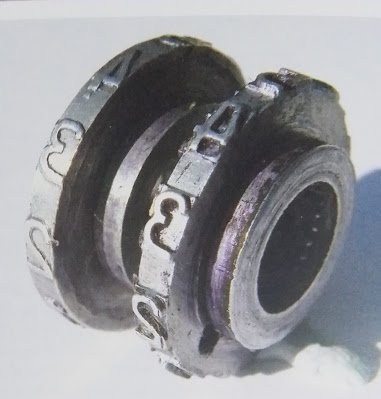Bellgraphic Versus Gibson
This, readers may remember from yesterday, is the inside of a Bellgpaphic ticket machine. On the right passenger tickets plus carbon copy paper; and on the left the copies retained in the machine after the tickets have been issued. The main mechanism is a lever and ratchet which moves the tickets on one by one as they are issued.
Here is Mr Gibson's machine. To help readers with legibility, fbb has split the phot into two.The dial that selects the correct fare is the black wheel on the left, enlarged in the box, bottom left. Continuing to the right (with overlap) ...... where the wheels to set stage and ticket type are located. There were approximately 650 parts in a Gibson ticket machine and its daddy and creator made the first oner all by himself out of brass. The assemble machine, a;so in two parts are from a different angle to confuse us all ia below. The left hand (from the conductors point of view) has the fare change wheel ...... and the other end the two most regularly used settings.The date and route wheels were set by the "back office" before the machine in its box was issued at the start of each shift.
All this is covered in Andrew Cross' excellent and strongly recommended book ...... indeed it was Mr Cross' father who drew the "exploded" diagram of the Gibson Machine, a true "tour de force"!
In fascinating detail, the book covers th development of the system. Attempts were made to reduce costs, for example.The wheels that printed the fare on the ticket roll were cast metal (above right), and thus expensive to make, and expensive to replace when the inevitable fare increases rolled along at regular intervals. So they tried stamping out the values on thinner metal - easier to do and cheaper too. But tje numbers wore out too quickly and any cost advantages of production were soon lost in the additional cost of replacements.
It was rapid inflation that led to another cunning plan. Tickets machines were equipped, not with ticket-price numbers, but with letters.When fares were increased, it was only necessary to change the values for each letter with a notice on the buses and a change of calculation in the back office. Clever, eh?
But the age of mechanical calculation was to be usurped by electronics and the book explains the process of converting to the well-remembered Wayfarer system, both for on-bus one man operation and round the necks of the conductor.And, of course, we have moved on further to the popular and complex Ticketer.Feed in a ball of wool, they say, and it will knit you a nice woolly scarf!
Change of BlindIt seem highly UNlikely that it will be a happy new year for the bus industry and, it seems, an even unhappier one for the railways.
But ever optimistically, fbb wishes all his readers the compliments of the season.The old man has the monthly Christian meetings tomorrow and Monday in the fbb home, and the theme is CHRISTmas. Remember that the Chirch Fathers of old organised the ecclesiastical calendar so that the Preparation for Christmas took place during Advent (December). Christmas started at Midnight on 24th December and finished on Twelfth Night, 6th January,
Far more satisfactory than the modern extended Spend-mas a k a Kriss-mus!
Next Variety blog : Sunday 2nd January















Two of my bugbears with Ticketer:
ReplyDelete- passengers who wave their debit cards at the machine rather than holding them still or laying them flat;
- those who pay with a phone app but don't call it up until getting onto the bus.
To be fair, those are bugbears with any modern ticket system, especially the waiting until getting on the bus before getting pass/phone/whatever out.
ReplyDelete